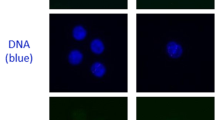Abstract
The aim of this work was to study the effect of proton pencil beam scanning in the Bragg peak in the dose range of 0.1–1.5 Gy on the induction of cytogenetic damage in the bone marrow, reactive oxygen species (ROS) production in whole blood, and the state of lymphoid organs after total body irradiation of mice. Irradiation was carried out in the Prometeus proton synchrotron (Protvino) in the Bragg peak with proton energy at the output of 90–116 MeV. It was found that, under irradiation of mice in the range of low and medium doses of proton pencil beam scanning in the Bragg peak, the relative biological effectiveness (RBE) according to the criterion of cytogenetic changes was 1.15. In addition, it was found that the pathophysiological effect on the lymphoid organs and the production of ROS by blood cells were different as compared with the effect of X-rays.



Similar content being viewed by others
REFERENCES
Paganetti, H., Blakely, E., Carabe-Fernandez, A., et al., Report of the AAPM TG-256 on the relative biological effectiveness of proton beams in radiation therapy, Med. Phys., 2019, vol. 46, no. 3, pp. 53–78.
Luhr, A., Neubeck, C., Krause, M., et al., Relative biological effectiveness in proton beam therapy—current knowledge and future challenges, Clin. Transl. Radiat. Oncol., 2018, vol. 9, pp. 35–41.
Khmelevskii, E.V., Radiation therapy for prostate cancer: photons, protons, or heavy ions?, Radiats. Onkol. Yad. Med., 2013, no. 1, pp. 28–33.
Held, K.D., Kawamura, H., Kaminuma, T., et al., Effects of charged particles on human tumor cells, Front. Oncol., 2016, vol. 6, art. 23.
Ivanov, A.A., Bychkova, T.M., Nikitenko, O.V., et al., Radiobiological effects of protons, Med. Radiol. Radiats. Bezop., 2019, vol. 64, no. 3, pp. 19–31.
Direktiva 2010/63/eu Evpopeiskogo parlamenta i Soveta Evpopeiskogo soyuza ot 22 sentyabrya 2010 g. po okhrane zhivotnykh, ispol’zuemykh v nauchnykh tselyakh (Directive 2010/63/EU of the European Parliament and the Council of the European Union of September 22, 2010, on the Protection of Animals Used for Scientific Purposes), St. Petersburg: Rus-LASA “NP ob’’edinenie spetsialistov po rabote s laboratornymi zhivotnymi,” rabochaya gruppa po perevodam i izdaniyu tematicheskoi literatury, 2012.
Klokov, D.Yu., Patterns of formation of radiation adaptive response in bone marrow cells of mice in vivo, Cand. Sci. (Biol.) Dissertation, 2000.
Tommansino, F. and Durante, M., Proton radiobiology, Cancers, 2015, pp. 353–381.
Calugaru, V., Nauraye, C., Noel, G., Giocanti, N., et al., Radiobiological characterization of two therapeutic proton beams with different initial energy spectra used at the Institut Curie Proton Therapy Center in Orsay, Inst. J. Radiat. Oncol. Biol. Phys., 2011, vol. 81, no. 4, pp. 1136–1143.
Finnberg, N., Wambi, C., Ware, J.H., et al., Gamma-radiation (GR) triggers a unique gene expression profile associated with cell death compared to proton radiation (PR) in mice in vivo, Cancer Biol. Ther., 2008, vol. 7, no. 12, pp. 2023–2033.
Giedzinski, E., Rola, R., Fike, J.R., et al., Efficient production of reactive oxygen species in neural precursor cells after exposure to 250 MeV protons, Radiat. Res., 2005, vol. 164, no. 4, pp. 540–544.
Naranga, H., Kumara, A., Bhat, N., et al., Effect of proton and gamma irradiation on human lung carcinoma cells: gene expression, cell cycle, cell death, epithelial-mesenchymal transition and cancer-stem cell trait as biological end points, Mutat. Res., 2015, vol. 780, pp. 35–46.
Funding
The effect of low and medium doses of protons on the hematopoietic organs during total irradiation of mice was studied using pencil proton beam scanning technology at the Physical Technical Center of Lebedev Physical Institute and at the Institute of Theoretical and Experimental Biophysics, Russian Academy of Sciences, within the framework of basic research under state assignment topics and with partial support by the R&D agreement no. 01/19 between the Physical Technical Center of Lebedev Physical Institute and the Institute of Theoretical and Experimental Biophysics of the Russian Academy of Sciences.
Author information
Authors and Affiliations
Corresponding authors
Ethics declarations
Conflict of interest. The authors declare that they have no conflict of interest.
Statement on the welfare of animals. All manipulations with mice were performed in accordance with the regulatory legal acts on the experimental work with animals [6], and the experimental plan was approved by the Commission on Biological Safety and Bioethics of the Institute of Theoretical and Experimental Biophysics (Protocol no. 4 from April 5, 2018).
Additional information
Translated by M. Batrukova
Rights and permissions
About this article
Cite this article
Balakin, V.E., Rozanova, O.M., Smirnova, E.N. et al. The Effect of Low and Medium Doses of Proton Pencil Scanning Beam on the Blood-Forming Organs during Total Irradiation of Mice. Dokl Biochem Biophys 494, 231–234 (2020). https://doi.org/10.1134/S1607672920050026
Received:
Revised:
Accepted:
Published:
Issue Date:
DOI: https://doi.org/10.1134/S1607672920050026




